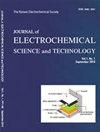The Investigation of COD Treatment and Energy Consumption of Urban Wastewater by a Continuous Electrocoagulation System
IF 3
4区 工程技术
Q3 ELECTROCHEMISTRY
Journal of electrochemical science and technology
Pub Date : 2022-04-14
DOI:10.33961/jecst.2021.00647
引用次数: 1
Abstract
In this study, electrochemical treatment of urban wastewater with electrical conductivity of 1000 µS cm -1 and chemical oxygen demand of 250 mg L -1 was investigated using the variables of initial pH value, current density and flow rate. Electrocoagulation was used, in which aluminum and stainless steel were selected, as the electrochemical treatment process. The electrocoagulation process was operated in continuous mode. The data obtained in experimental studies show that the best COD removal efficiency occurred in experiments where the initial pH value was 6. The increase in current density from 5 A to 15 A decreased the removal efficiency from 79 to 67%. The increase in flow rate under constant current density also reduced the efficiency of removal as expected. In experiments in which current density and flow rate were examined together, the increase in flow rate allowed the application of higher current densities. This situation led to considerable reductions in energy consumption values, even if the COD removal efficiency did not significantly increase. The high COD removal obtained with the use of high flow rate and high current density indicates that the electrocoagulation process can be used for high flow rate municipal wastewater treatment.连续电絮凝系统处理城市污水COD及能耗研究
以电导率为1000µS cm -1、化学需氧量为250 mg L -1的城市污水为研究对象,以初始pH值、电流密度和流速为变量,进行了电化学处理。采用电絮凝法,选择铝和不锈钢作为电化学处理工艺。电凝过程在连续模式下运行。实验研究数据表明,初始pH值为6时,COD去除率最佳。当电流密度从5 A增加到15 A时,去除率从79%下降到67%。恒流密度下流速的增加也如预期的那样降低了去除效率。在电流密度和流速同时进行的实验中,流速的增加允许应用更高的电流密度。这种情况导致能耗值显著降低,即使COD去除效率没有显著提高。在大流量、大电流密度条件下获得的高COD去除率表明电絮凝工艺可用于大流量城市污水处理。
本文章由计算机程序翻译,如有差异,请以英文原文为准。
求助全文
约1分钟内获得全文
求助全文
来源期刊

Journal of electrochemical science and technology
ELECTROCHEMISTRY-
CiteScore
6.30
自引率
8.10%
发文量
44
期刊介绍:
Covering fields:
- Batteries and Energy Storage
- Biological Electrochemistry
- Corrosion Science and Technology
- Electroanalytical Chemistry and Sensor Technology
- Electrocatalysis
- Electrochemical Capacitors & Supercapcitors
- Electrochemical Engineering
- Electrodeposition and Surface Treatment
- Environmental Science and Technology
- Fuel Cells
- Material Electrochemistry
- Molecular Electrochemistry and Organic Electrochemistry
- Physical Electrochemistry
- Solar Energy Conversion and Photoelectrochemistry
 求助内容:
求助内容: 应助结果提醒方式:
应助结果提醒方式:


